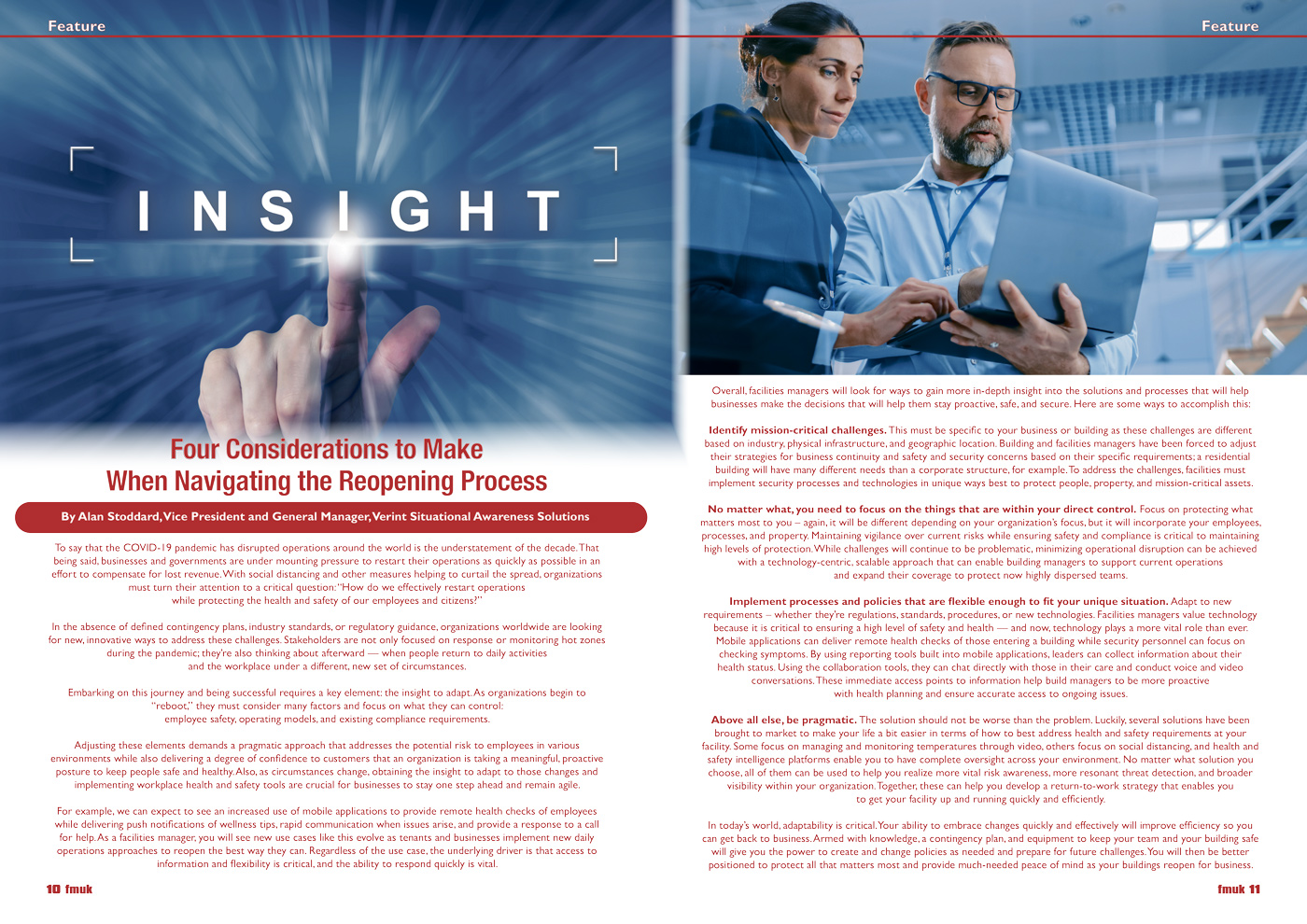Four Considerations to Make When Navigating the Reopening Process
 By Alan Stoddard, Vice President and General Manager, Verint Situational Awareness Solutions
By Alan Stoddard, Vice President and General Manager, Verint Situational Awareness Solutions
To say that the COVID-19 pandemic has disrupted operations around the world is the understatement of the decade. That being said, businesses and governments are under mounting pressure to restart their operations as quickly as possible in an effort to compensate for lost revenue. With social distancing and other measures helping to curtail the spread, organizations must turn their attention to a critical question: "How do we effectively restart operations while protecting the health and safety of our employees and citizens?"
In the absence of defined contingency plans, industry standards, or regulatory guidance, organizations worldwide are looking for new, innovative ways to address these challenges. Stakeholders are not only focused on response or monitoring hot zones during the pandemic; they're also thinking about afterward — when people return to daily activities and the workplace under a different, new set of circumstances.
Embarking on this journey and being successful requires a key element: the insight to adapt. As organizations begin to "reboot," they must consider many factors and focus on what they can control: employee safety, operating models, and existing compliance requirements.
Adjusting these elements demands a pragmatic approach that addresses the potential risk to employees in various environments while also delivering a degree of confidence to customers that an organization is taking a meaningful, proactive posture to keep people safe and healthy. Also, as circumstances change, obtaining the insight to adapt to those changes and implementing workplace health and safety tools are crucial for businesses to stay one step ahead and remain agile.
For example, we can expect to see an increased use of mobile applications to provide remote health checks of employees while delivering push notifications of wellness tips, rapid communication when issues arise, and provide a response to a call for help. As a facilities manager, you will see new use cases like this evolve as tenants and businesses implement new daily operations approaches to reopen the best way they can. Regardless of the use case, the underlying driver is that access to information and flexibility is critical, and the ability to respond quickly is vital.
Overall, facilities managers will look for ways to gain more in-depth insight into the solutions and processes that will help businesses make the decisions that will help them stay proactive, safe, and secure. Here are some ways to accomplish this:
Identify mission-critical challenges. This must be specific to your business or building as these challenges are different based on industry, physical infrastructure, and geographic location. Building and facilities managers have been forced to adjust their strategies for business continuity and safety and security concerns based on their specific requirements; a residential building will have many different needs than a corporate structure, for example. To address the challenges, facilities must implement security processes and technologies in unique ways best to protect people, property, and mission-critical assets.
No matter what, you need to focus on the things that are within your direct control. Focus on protecting what matters most to you – again, it will be different depending on your organization's focus, but it will incorporate your employees, processes, and property. Maintaining vigilance over current risks while ensuring safety and compliance is critical to maintaining high levels of protection. While challenges will continue to be problematic, minimizing operational disruption can be achieved with a technology-centric, scalable approach that can enable building managers to support current operations and expand their coverage to protect now highly dispersed teams.
Implement processes and policies that are flexible enough to fit your unique situation. Adapt to new requirements – whether they’re regulations, standards, procedures, or new technologies. Facilities managers value technology because it is critical to ensuring a high level of safety and health — and now, technology plays a more vital role than ever. Mobile applications can deliver remote health checks of those entering a building while security personnel can focus on checking symptoms. By using reporting tools built into mobile applications, leaders can collect information about their health status. Using the collaboration tools, they can chat directly with those in their care and conduct voice and video conversations. These immediate access points to information help build managers to be more proactive with health planning and ensure accurate access to ongoing issues.
Above all else, be pragmatic. The solution should not be worse than the problem. Luckily, several solutions have been brought to market to make your life a bit easier in terms of how to best address health and safety requirements at your facility. Some focus on managing and monitoring temperatures through video, others focus on social distancing, and health and safety intelligence platforms enable you to have complete oversight across your environment. No matter what solution you choose, all of them can be used to help you realize more vital risk awareness, more resonant threat detection, and broader visibility within your organization. Together, these can help you develop a return-to-work strategy that enables you to get your facility up and running quickly and efficiently.
In today's world, adaptability is critical. Your ability to embrace changes quickly and effectively will improve efficiency so you can get back to business. Armed with knowledge, a contingency plan, and equipment to keep your team and your building safe will give you the power to create and change policies as needed and prepare for future challenges. You will then be better positioned to protect all that matters most and provide much-needed peace of mind as your buildings reopen for business.






















































